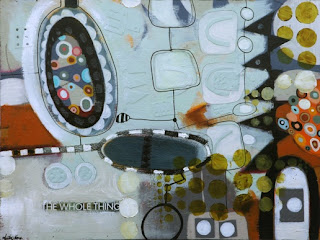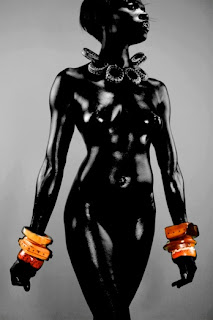Each artist’s legacy is defined by his or her own life philosophies and achievements. Some make a pronounced impact on the world because of their art, but others see beyond their own work, and choose to give back for a more substantial purpose. Altruism is at the core of Daniel Simmons creative legacy, because it not only nourishes the people, but it also feeds his soul. This need to care, give, and serve is an innate quality that was nurtured by his loving family.
 |
| The artist at work |
Daniel Simmons was born in Jamaica, Queens in August of 1953. He is the eldest brother of executive Russell Simmons and rapper Joseph Simmons (Rev Run of Run DMC). His father Daniel Simmons Sr. was professor of black history and an active participant in the Civil Right’s movement, while his mother, Evelyn Simmons was teacher who created art in her spare time.
 |
| © Danny Simmons |
Simmons says that he can remember creating from a very young age with the support of his mother who brought him art supplies and taught him how to paint. Like most artistically inclined kids, as he grew, he drew comic book characters to feed his creative urge. At age 12, however, he says girls and other teenage concerns distracted him, and art took a backseat in his life.
 |
| © Danny Simmons |
He attended Benjamin Cardoza High School in Queens, N.Y., but was not creating consistently during those times. After high school he enrolled in college at Lincoln University in Pennsylvania. He stayed there for two years, eventually returning to Queens so that he could attend New York University (NYU) to study social work. During his studies, he started to take art classes and began, “enjoying doing art again.” Although he enjoyed creating art, he didn’t enjoy the formal art classes so he decided to venture out on his own as an artist. Simmons received a degree in social work from NYU, and began working in his field right after graduation. He had also continued creating art, and was doing both for a time. He eventually grew tired of social work, and delved fully into his art.
 |
| © Danny Simmons |
As a child, Simmons remembers working with his father during the civil rights movement. He watched his father give back to the community and promote change by helping children and adults. It appears that Simmons learned much from his father’s kind behavior and his willingness to help people be better, because he chose to become a social worker. Simmons upbringing, his innate care and concern for the people, and his community fed his need to give back using the medium that he was most passionate about, art.
 |
| © Danny Simmons |
In 1995, he established Rush Philanthropic Arts Foundation with his brother Russell Simmons. Initially, the project was born out of a need for him to secure more exhibitions for himself. Soon, he began to see that there weren’t many galleries supporting black artists, women, and artists of color, so he decided to change the direction of the project. It grew from a small idea into a successful nonprofit organization. With the support of his brothers, they organized a fundraiser, and raised nearly a quarter of a million dollars for the organization. The monies helped to fund the gallery, and support the children and artists of color that he was passionate about giving opportunity to.
 |
| © Danny Simmons |
Simmons describes his early works as “figurative abstracts,” and compares them to the works of Picasso. He painted for years while trying to find his creative voice, but it wasn’t until his early thirties that he found that voice. He says of his work during that time, “I was creating for myself, and not what I was emulating from other artists.”
 |
| © Danny Simmons |
As a lover of art, and specifically works that have strong African influence, Simmons knew that his work needed to reflect some of those same elements. He realized that many of the artists that he admired and studied, like Picasso, took ideas from the same African influences, and created their work around that. Simmons says he wanted to create more spiritual work, so he began to look past the literal, and attempted to find a more divine purpose in his work.
 |
| © Danny Simmons |
“My art is really about the spirit and how to connect with the spirit,” he says of his large contemporary abstracts. He says that he hasn’t delved back into figurative work, but often times he thinks about it. For him it is more important to speak his truth through his work, and he finds it much easier to express that truth through his non-representational pieces.
 |
| © Danny Simmons |
Simmons says that as an artist, he too has faced many challenges, and has faced difficulty finding shows and selling work. He also says that one of the biggest challenges he faced was the need to continue to grow as an artist, and not stay in the same place. He says he still deals with trials daily, and calls the journey a consistent “hustle.”
 |
| © Danny Simmons |
Simmons encourages emerging artists to not give up. He feels that artists should continue to focus on their work no matter what. “Sometimes you have to work part time and paint part time. There are all types of challenges that come up, but being an artist is more of a spiritual pursuit than an economic pursuit,” he opines.
 |
| © Danny Simmons |
Daniel Simmons is also an avid collector of art, and a full supporter of artists. His work has been widely collected, and hangs in the collection of many prestigious organizations. He serves on many boards, and he continues to create opportunities for emerging artists of color so that they have an opportunity to find their creative voices. His large expressionist abstracts continue to inspire us all to find the spirit within.
“The satisfaction that one gets out of being a creative far outweighs anything that I can think of in life.”
–Danny Simmons, 2013
___________________________________
“Because of the hype many artists pursue fame and fortune, but true artists pursue the work, so it’s important to remain true to who we are.”
–Danny Simmons, 2013
All images are © copyrighted by the artist unless otherwise noted. Images cannot be reproduced without permission of the artist.
Cultured Artists™ ©2013
























































